Flowering Vines For Shade (9 Perennial Climbers That Won’t Take Over Your Garden)
Need to hide your neighbor's shed or soften the lines of a fence or trellis? These flowering perennial vines for shade are the perfect solution…they're pretty and practical.

When I first moved into my house, as with most new construction builder-grade houses, there wasn't an inch of shade to be found. Being out in the yard in the summer with that sun beating down felt like being in an oven. In fact, the yard was so devoid of life that the backyard didn't even have any grass!
Of course, being someone who loves to garden, I couldn't have a yard with no plants! So I set out to create some garden beds. And to help out with the shade situation, I made sure to plant a lot of bushes and small trees that would help cool things down a bit.
I had just moved to South Carolina so I had no idea how fast everything grows here compared to Toronto…and I can tell you, the longer growing season definitely makes a difference!
So now my hot as blazes full-sun yard has turned into a much cooler, mostly shady garden. And that means finding plants that thrive in the shade to replace the sun-loving varieties that aren't doing so well anymore.
Like climbing roses. I used to grow them up the fence and over arbors to add some color and block my view of the neighbor's shed, but they don't do very well with so little sun.
So I've been looking for some flowering vines for shade that can take their place.
And I've discovered that finding shade vines that aren't invasive plants is actually pretty hard. Which is why I haven't included some of the common plants you usually see on these lists (like trumpet vine, ivy and honeysuckle).
But after doing some research I've finally been able to come up with a list of flowering vines for shade that I should be able to grow without creating a whole bunch of extra work for myself. (I strive to have a low maintenance garden!)
Keep reading to find out what they are.
1 | Climbing Hydrangea (Hydrangea petiolaris)
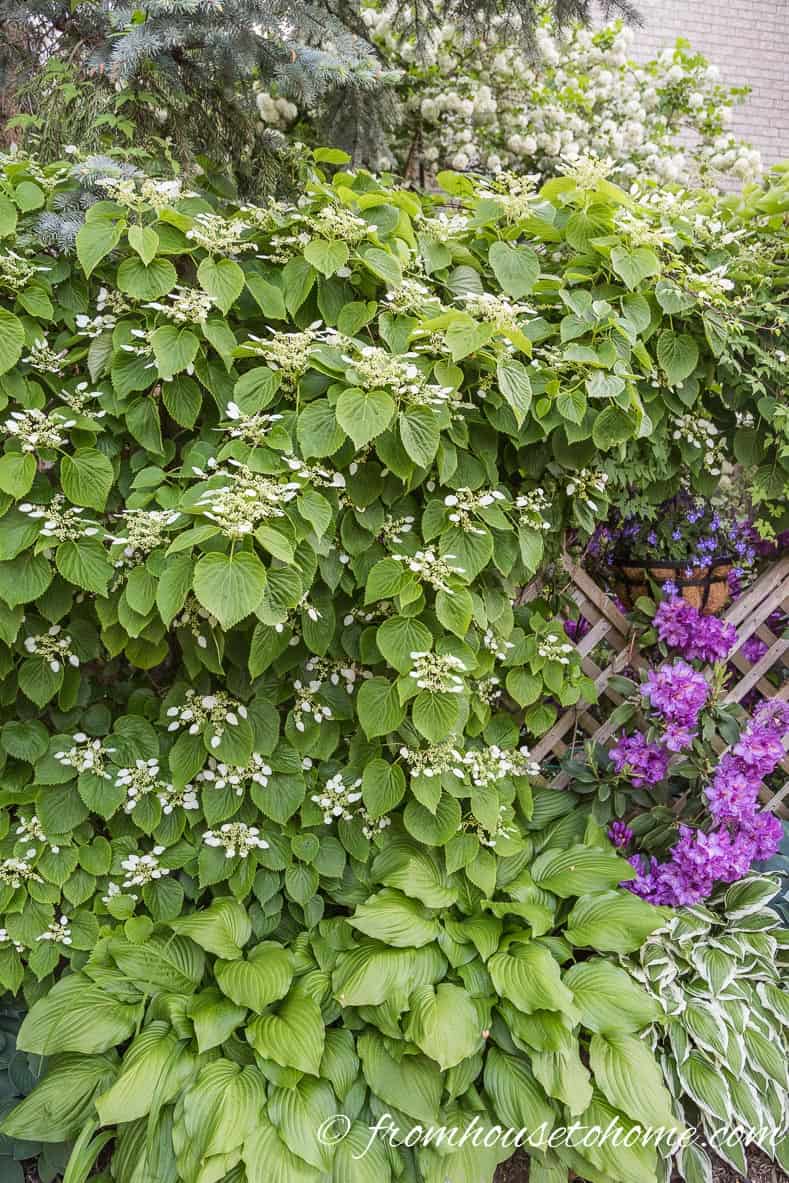
Zones: 4 to 9
Light: Shade to part shade
Bloom Time: Late spring to summer
Height: 40′ to 60′
Spread: 10′ to 15′
Climbing hydrangeas (Hydrangea petiolaris) are notoriously slow to get started, and can take up to 5 years to get going. I was about to give up on mine when it finally took off!
However, once they do start to grow, they are worth the wait.
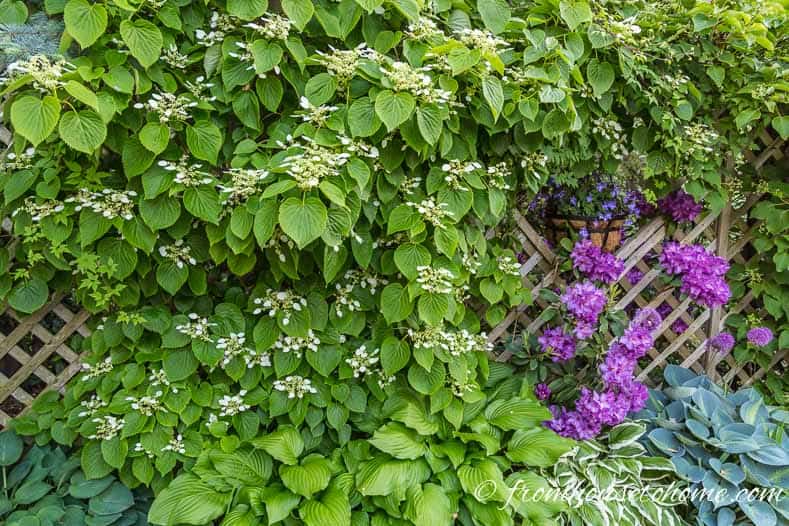
Imagine a whole wall of lacy white flowers, because that's what you'll have if you're patient.
They are rather heavy plants and can get very tall so make sure you have them planted on a sturdy structure with room to grow.
Click HERE to find out more about Climbing Hydrangeas.
2 | Japanese Climbing Hydrangea (Schizophragma hydrangeoides)

Zones: 5 to 9
Light: Part shade to shade
Bloom Time: Summer
Height: 30′ to 40′
Spread: 5′ to 8′
The Japanese Climbing Hydrangea (Schizophragma hydrangeoides) is in the same plant family as the other climbing Hydrangea, and it takes just as long to get going!
It has large, lacy 8″ to 10″ flowers that look really pretty cascading down the side of a fence.

The most common variety ‘Moonlight' has white flowers, but there is also a pink-flowered version (‘Roseum').
If you are looking for a shade vine for the North side of your house, this could be the plant for you.
Find out more about Japanese Climbing Hydrangea HERE.
3 | Native Climbing Hydrangea or Woodvamp (Hydrangea barbara)
![Native Climbing Hydrangea or Woodvamp by Ciftonia (Own work) [Public domain], via Wikimedia Commons](https://www.fromhousetohome.com/garden/wp-content/uploads/sites/2/2017/07/decumaria_barbara3.jpg)
Zones: 5 to 10
Light: Part shade to shade
Bloom Time: Summer
Height: 30′ to 40′
Spread: 30′ to 40′
Are you sensing a trend here? The different versions of Climbing Hydrangeas are very popular shade vines!
This climbing Hydrangea (Hydrangea barbara, previously known as Decumaria barbara), also known as Woodvamp, is native to the Southeastern United States and is another beautiful flowering vine for the shade.
Its flowers are not as large as the cultivated climbing hydrangeas but they still put on a show. And the butterflies love it!
However, it will only bloom when climbing, so don't use it as a groundcover if you want it to produce flowers.
Click HERE to find out more about the native climbing Hydrangea.
4 | Clematis

Zones: 3 to 9
Light: Part shade
Bloom Time: Spring to fall (depending on the variety)
Height: 3′ to 25′
Spread: 2′ to 6′
Okay, that's it for the Climbing Hydrangeas. Now onto Clematis…one of my all time favorite plants!
There are Clematis varieties in all kinds of colors (my favorites are the ones with purple flowers) and it is generally a very well behaved vine.

It won't bloom very well in full shade, but almost all of the 27 varieties that I grow in my garden are in part shade and loving it!
One caveat: If you want low maintenance plants, stay away from sweet Autumn Clematis which can be quite invasive in some areas.
You can find more information on growing Clematis and the best varieties for your garden HERE.
5 | Variegated Kiwi Vine (Actinidia kolomikta)

Zones: 3 to 8
Light: Part shade
Bloom Time: Spring
Height: 25′
Spread: 8′ to 10′
The kiwi vine has small white flowers in the spring but that's not why most people grow it.
In light shade, it produces leaves that are a spectacular pink, white and green combination.
It comes in a female and male version (you'll need both if you actually want to grow fruit).
For the best colors, try to get a male plant since it tends to have better variegation on the leaves than the females.
For more Kiwi Vine information, click HERE.
Find live plants at your local nursery or buy seeds HERE.*
6 | Variegated Magnolia Vine (Kadsura japonica)
Zones: 7 to 10
Light: Shade to part shade
Bloom Time: Spring
Height: 10′ to 15′
Spread: 2′ to 15′
For gardeners that live in warmer zones, Kadsura japonica is a great shade vine to try.
It is a semi-evergreen to evergreen vine that grows in the shade, is deer resistant and produces white or yellow flowers in the spring.
But most of the time, it is grown for the beautiful red berries it produces in the fall and variegated leaves that stand out in the shade garden.
![Kadsura japonica by KENPEI (Own work) [GFDL or CC BY-SA 3.0], via Wikimedia Commons](https://www.fromhousetohome.com/garden/wp-content/uploads/sites/2/2017/07/kadsura_japonica1.jpg)
Like the Kiwi vine, you will need both a male and a female plant in order to get fruit.
Read more about Kadsura japonica HERE.
They can be a little hard to find online, but I did come across this nursery that carries them.
7 | Confederate Jasmine (Trachelospermum jasminoides)

Zones: 7B to 10
Light: Part shade
Bloom Time: Spring to early summer
Height: 15′ to 20′
Spread: 4′ to 6′
If you live in the South and are looking for a beautiful flowering vine with evergreen leaves that will grow in part shade, you might want to consider Confederate Jasmine.
Once it is established, it is absolutely covered with white (or pink), star shaped flowers have also earned it the name Star Jasmine.

It isn't picky about the type of soil it is planted in, puts on a big show in the spring and smells heavenly!
For more information on Confederate Jasmine, click HERE.
8 | Butterfly Vine (Mascagnia macroptera)
![By Clinton & Charles Robertson from RAF Lakenheath, UK & San Marcos, TX, USA & UK [CC BY 2.0], via Wikimedia Commons](https://www.fromhousetohome.com/garden/wp-content/uploads/sites/2/2017/07/butterfly_vine_390005819.jpg)
Zones: 8 to 10
Light: Part shade
Bloom Time: Spring to fall
Height: 10′ to 12′
Spread: 10′
The butterfly vine is a fast growing climber that is native to California. It will grow in part shade and produces yellow flowers in the spring and summer that eventually turn brown.
It gets its common name from the papery seed pods that are shaped like butterflies.
Although it is perennial only in the warmest zones of North America, since it grows quickly it can be used as an annual vine further North.
Click HERE to find out more about the butterfly vine.
9 | Groundnut (Apios americana)
![Groundnut by Fritzflohrreynolds (Own work) [CC BY-SA 3.0], via Wikimedia Commons](https://www.fromhousetohome.com/garden/wp-content/uploads/sites/2/2017/07/apios_americana_-_groundnut.jpg)
Zones: 3 to 10
Light: Shade
Bloom Time: Summer
Height: 25′ or longer
Spread: 8′ to 12′
I was a little hesitant about including the Groundnut (or potato bean) in this list of vines for shade because it can be somewhat aggressive.
But it's hard to leave it off the list since it's an easy-to-grow plant with flowers that look like red Wisteria!
Groundnut is a native plant found in Eastern North America that thrives in the shade, blooms from July to September and attracts butterflies.
As I mentioned above, it is a very vigorous grower so you probably don't want to plant it in the garden bed with your favorite perennials.
But if you have a shady spot where it can spread out, it will put on quite a show.
And if you want to keep them from spreading too much, the tubers are edible, apparently tasting something like potatoes only sweeter.
You can find out more about the groundnut HERE.
That's it for my list of (mostly) non-invasive vines that grow in the shade.
I know I'm going to try at least a couple of these in mine…and the neighbor's shed will be gone (at least from view)!
Hopefully, you have found one or two that will make a statement in your garden, too.
Other Shade Loving Plants You Might Like
Have comments or questions on flowering vines for shade? Tell us in the section below.
Pin It So You Don't Forget It!

This post was originally published on July 28, 2017 but was updated with new content on November 23, 2024.

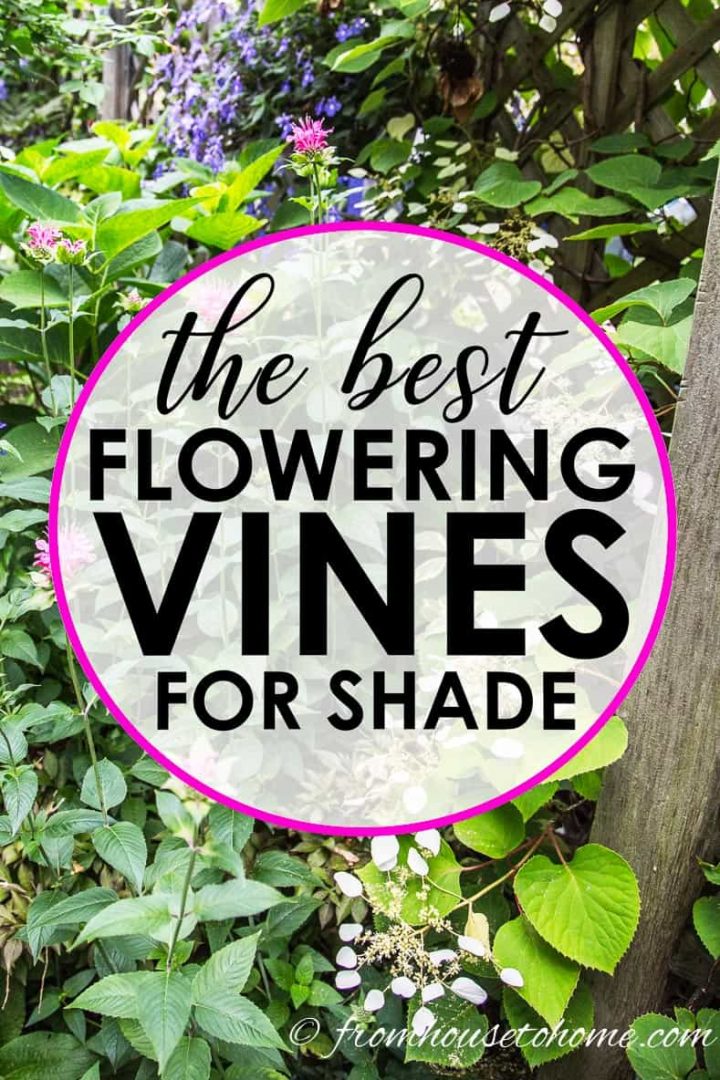

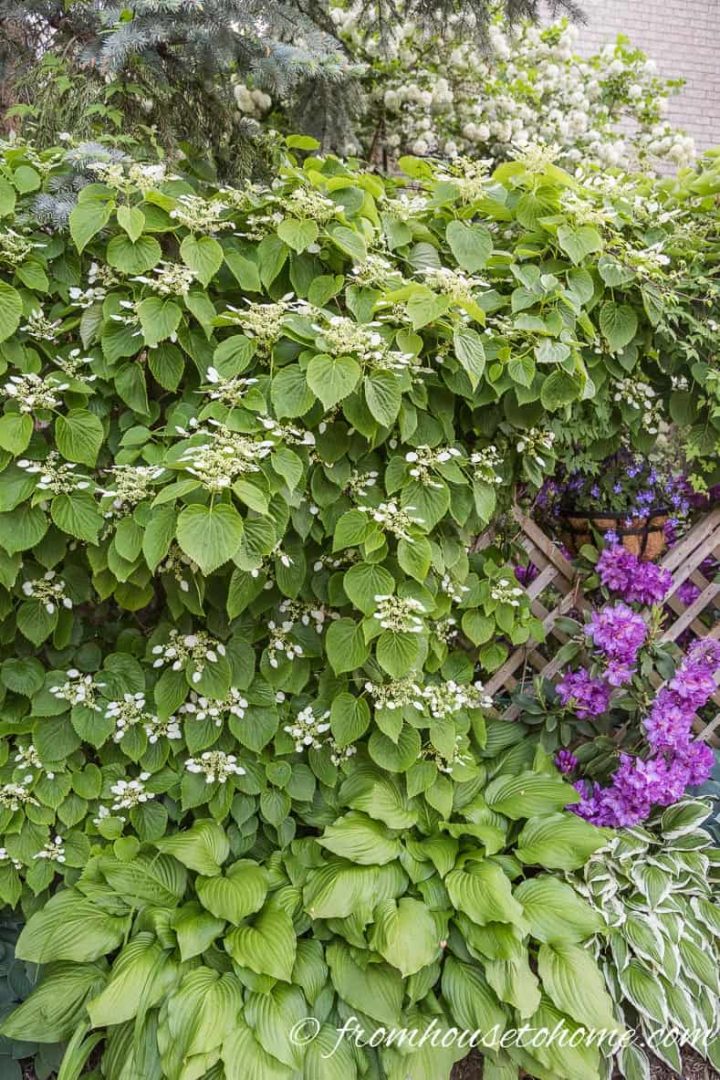
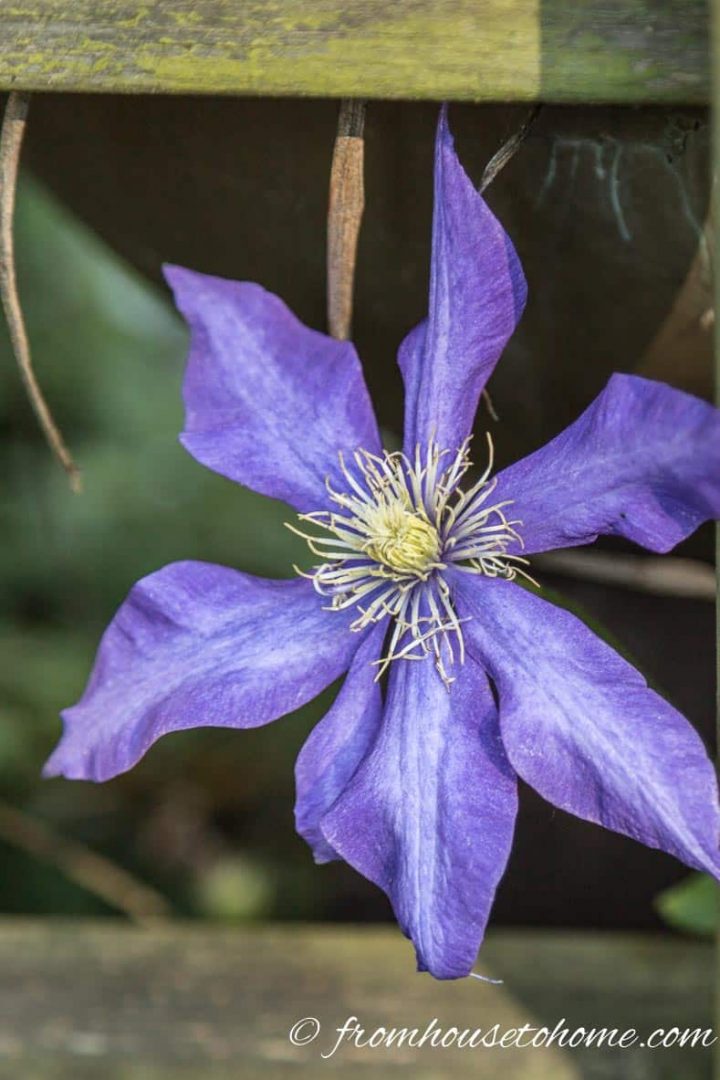
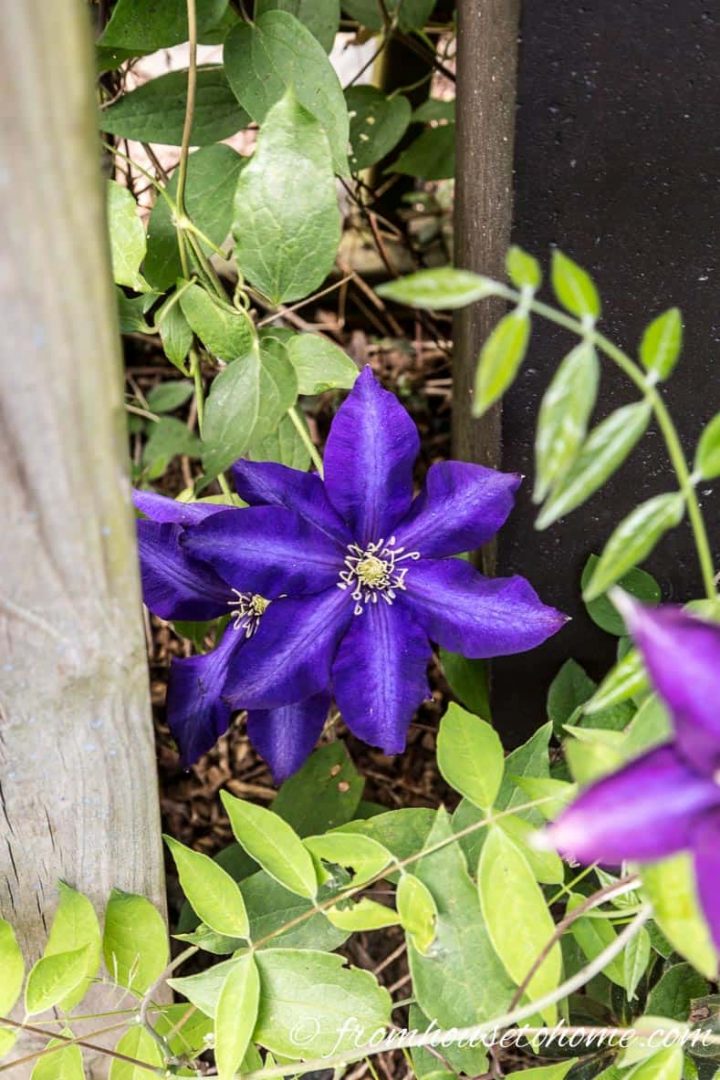
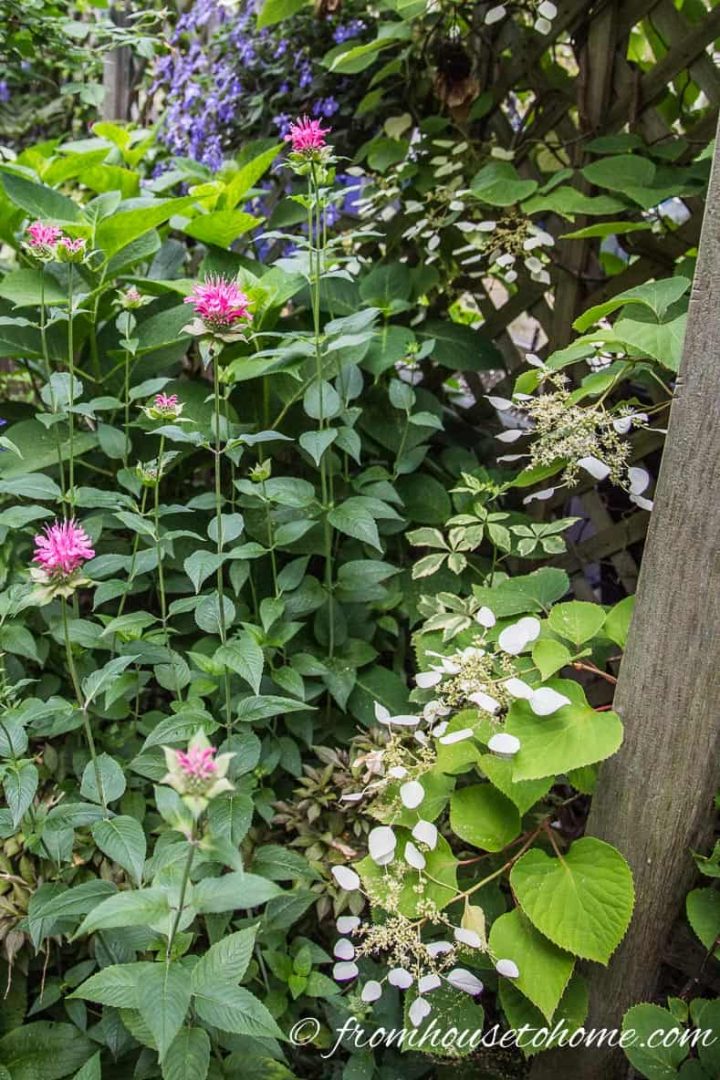





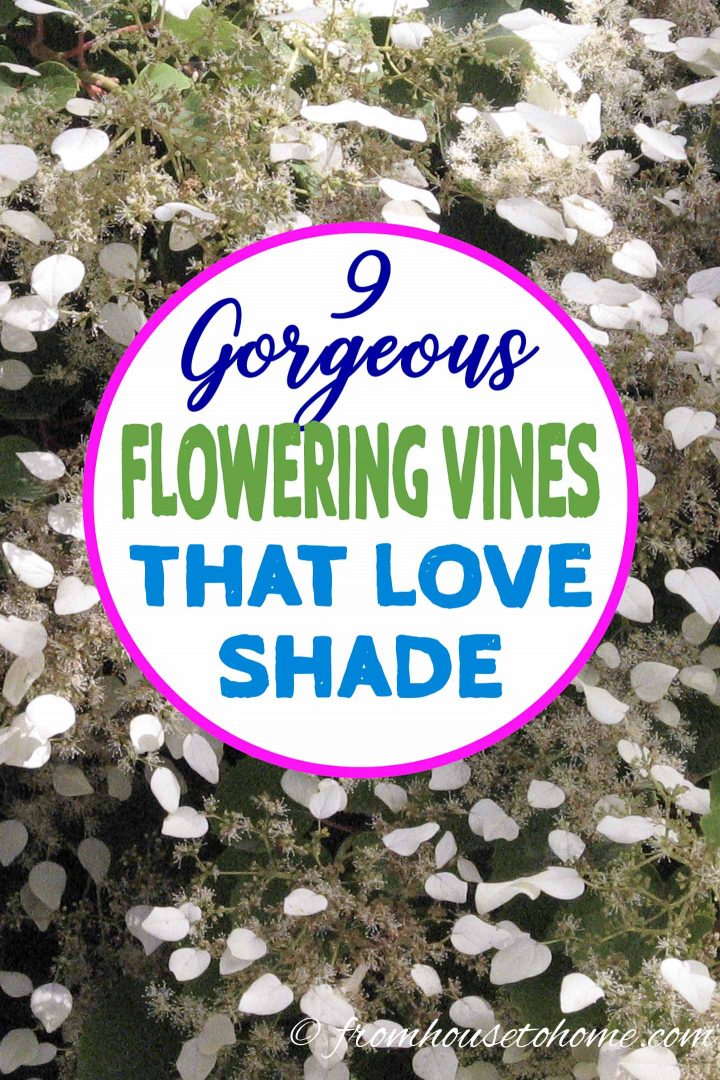















Informative and interesting… Do you sell these plants?
Thanks. Gina
[email protected]
Thanks, Gina! Sorry, we don’t sell the plants.
Hello Wanda,
I bought an home that’s about 110 years old. On the property is an old carriage house that needed to be torn down. Instead, I envisioned removing the doors and one wall and turning the dirt floor into a shade garden. I constructed an 8 x 4 control room in one corner that looks like a small store front and then built a raised pond in the center with a board walk that comes in form the long, open side, circles the pond and exits out the front where the carriage house door used to be. The lumber from the board walk is all reclaimed from the removed wall, so it’s very rustic. I’m looking to plant some deep shade vines along with other shade loving plants. I’d like to have it look mysterious and unusual. I’m incorporating a few lighting affects and hidden speakers for soft, quiet instrumental music. Can you give me some ideas for plants that would do well in that atmosphere. I bought some see from China, but haven’t planted them yet and have no idea what they are. I tried to get some additional seed from that location, but they were confiscated and destroyed by our department a agriculture, so no telling what they might have been like. I’m not into drugs or crime… just an old 77 year old man who likes plants that are a little strange.
Thanks for your help.
Hi Daniel…your garden sounds very mystical 🙂 It’s hard to find shade vines that aren’t really invasive. The ones I listed here are the only ones I have experience with that I can vouch for. But I think you could look into some North American native plants like Jack-in-the-pulpit (it has interesting flowers), Cinnamon fern or Interrupted fern (they are large plants with unusual-looking seed stalks) and American Beautyberry (which has clusters of bright purple berries in the fall). Hope that helps! Good luck with your Chinese seeds!
Thank you! This list has been very helpful – I am also from Toronto now living in SC and getting used to new growing seasons and what and when to plant.
Thanks, Yasmin! I’ve been in SC for almost 20 years and I still underestimate how big and fast plants grow around here. But it is fun having such a long growing season 🙂
Hi Wanda
Love your blog!
What about the silver lace vine?
I would also like to know if any of these vines can be planted in containers (could be large) since I want to have it grow to cover a wall on a brick patio?
Thanks Carol
Thanks, Carol! I have heard that silver lace vine can be invasive. You might want to ask at a nursery in your area to see what they say. The only one of the vines in my list that I have tried in containers is Clematis and it does pretty well as long as the container is large enough and the base of the plant is protected from the sun (you might want to plant some kind of small bush in the planter with it to keep its roots cool). However it’s a twining vine, so to grow it on a wall, you would need to put up some kind of mesh (like chicken wire) or string picture wire across so it has something to grab on to. The other ones may do fine in large containers, too, but I don’t have any experience trying to grow them that way so I can’t say for sure.
Can you recommend a fast growing vine or flowering vines that will not attract bees or insects? It would be for a trellis that runs the perimeter of a front porch. Thanks!
Hi Maria…Of the vines I have grown, Clematis, butterfly vine and climbing roses (if you have sun) are the best for not attracting bugs and bees. But I found this article that has a few other suggestions (which I haven’t tried). Hope that helps!
Confederate Jasmine is pretty invasive in the Florida Panhandle. It will climb anything including your house. It is very hard to get rid of as well
Thanks for the tip, Jenny! One more to avoid 🙂
These vines all get pretty big. Any recommendations for someone with a really small space (north-facing patio area behind a townhouse)? Thanks!
Hi Elizabeth…you could try Clematis. There are different varieties that grow different heights, and most don’t get that big.